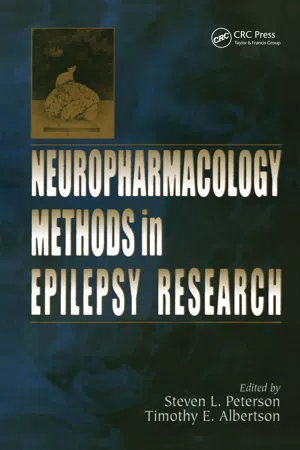
Neuropharmacology Methods in Epilepsy Research
- 272 pages
- English
- ePUB (mobile friendly)
- Available on iOS & Android
Neuropharmacology Methods in Epilepsy Research
About This Book
There is an estimated 2.5 million epileptics in the US and perhaps some 40 million worldwide. As research has become increasingly molecular in scope, fewer scientists are trained in the US on basic, integrated epilepsy techniques. One frustration in neuroscience today is the application of state-of-the-art molecular biology techniques to inappropriate animal models of epilepsy - frequently resulting in inconclusive results. Epilepsy research will be increasingly undertaken by scientists well-trained in reductionist methodology, but who may be unfamiliar with integrated, whole-animal techniques. This situation appears even more difficult considering there has been no updated textbook on experimental models of epilepsy over the last twenty years - until now. Neuropharmacology Methods in Epilepsy Research describes fundamental methodologies and procedures in this field, representing the only detailed text concerning experimental models of epilepsy published in the last 20 years. This guide studies the reproduction of well-characterized and readily interpretable experimental models of epilepsy to which state-of-the-art molecular biology techniques can be applied. Each chapter features: Introduction - providing a brief background and historical account of the techniques and their use Methodology - describing equipment, solutions, species, electrodes as well as considering variations of techniques and stimulation parameters Interpretations - demonstrating the relevance of techniques to epilepsy as well as describing what exactly is being studied and how the data is appropriately applied to understanding epilepsy Topics include electroshock, chemoconvulsions, kindling, audiogenic seizures, focal seizures, and brain slice preparations. Discussions also include: Recently developed seizure models, including status epilepticus and massed trial simulations Influence of circadian and diurnal rhythms on convulsive activity Behavior al and cognitive deficits associated with anticonvulsant drug testing Technical approaches, i.e. slice models, microdialysis techniques, intracranial implant surgery, audiogenic seizure testing, kindling paradigms, and the rhythmic nature of seizures This unique text provides a thorough reference for the diverse methodologies within this area of neuropharmacological research - providing the basis for on-going cellular and molecular investigations as well as novel therapeutic approaches to the treatment of epilepsy.
Frequently asked questions
Information
Index
Table of contents
- Cover
- Half Title
- Title Page
- Copyright Page
- The Editors
- Dedication
- Contributors
- Preface
- Table of Contents
- Electroshock
- Chemoconvulsants
- The Kindling Model of Temporal Lobe Epilepsy
- Rapid Kindling: Behavioral and Electrographic
- Experimental Models of Status Epilepticus
- Audiogenic Seizures in Mice and Rats
- Models of Focal Epilepsy in Rodents
- Evaluation of Associated Behavioral and Cognitive Deficits in Anticonvulsant Drug Testing
- Gene Targeting Models of Epilepsy: Technical and Analytical Considerations
- The Hippocampal Slice Preparation
- Microdialysis Techniques for Epilepsy Research
- Methodologies for Determining Rhythmic Expression of Seizures
- Index